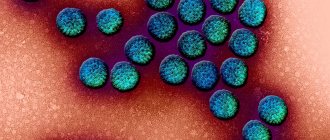Dysbacteriosis in children under one year of age is a common phenomenon. Many parents worry about their baby's intestines and stomach functioning as they should. After all, this determines how quickly the child will gain weight, how well the ingested vitamins and minerals will be absorbed, etc. True, not everyone knows the main symptoms of dysbiosis in infants. And they often panic for no reason.
Causes of dysbiosis in infants
With dysbacteriosis, skin rashes are very often observed.
Most parents think that dysbiosis can develop only if the child was given antibiotics at an early age or immediately after birth. Of course, the main reason will be medications, which in most cases have a detrimental effect on the microflora. But there are a number of other reasons due to which the microflora may be disrupted:
- Health problems for the mother while carrying the baby. This includes chronic diseases, as well as respiratory viral diseases.
- Difficult birth, as a result of which the child was without air for a long time or suffered some kind of infection
- A long stay in a maternity hospital, which, despite frequent cleaning, may not be particularly sterile
- Infections that can enter the baby’s body at any time. Most often these are either intestinal or respiratory viral infections
- Immaturity of intestinal motor function, mainly congenital
- Problems with the functioning of the gastrointestinal tract, namely frequent regurgitation in large quantities, constipation, etc.
- Late attachment to the mother's breast. Sometimes, if the birth was difficult for both mother and baby, breastfeeding is postponed. And because of this, problems may arise with the intestines, which did not receive colostrum on time
- Transferring a child to artificial formula
- Taking medications, such as antibiotics or hormones
- Postponed surgeries
- Poor environmental situation
- Constant stress and tension in which a newborn child lives
There are many reasons for the development of dysbiosis, and it is not always possible to protect a child from this.
Prevention of dysbacteriosis
The following measures help reduce the likelihood of developing dysbiosis:
- skin-to-skin contact immediately after birth;
- rational nutrition of the child - ideally breastfeeding and no supplementary feeding before the due date;
- washing hands before eating.
"SM-Doctor" is a modern medical center with wide diagnostic and therapeutic capabilities. We follow the example of leading clinics in Europe and the world and do everything necessary to improve the baby’s well-being in the shortest possible time. Contact professionals at a convenient time!
Symptoms of dysbiosis
Colic as a symptom of dysbiosis
Sometimes parents do not even suspect that their infant has dysbiosis. This is not due to their negligent attitude towards the baby’s health, but simply due to ignorance. And besides, during the first three months, many children suffer from intestinal colic. Their intestines simply have not yet adapted to the new conditions. And the weather also has its influence, mostly negative. The main symptoms of dysbiosis in infants include:
- Bloating. The baby’s belly seems to be inflated, it becomes very elastic to the touch, like an inflated balloon.
- Flatulence. If you put your hand on the baby’s belly, you can feel a constant rumbling, seething, which is accompanied by gases. Moreover, before the release of gases, the baby may tense up and cry
- Stomach ache. And while an older child can show where it hurts, a baby cannot do this. Therefore, the main sign of abdominal pain will be crying. But there is one more characteristic feature, how you can recognize that it is the tummy that hurts. During crying and the next spasm, the baby will press his legs, he will do this constantly until the pain subsides
- Bad breath. Everyone is used to the fact that little children should smell pleasant, or at least like milk. But if dysbiosis develops, the smell of your mouth can become unpleasant
- Salivation. And if for children older than 4 months this is considered the norm, as teeth begin to emerge, then for younger children, increased salivation can serve as a signal of illness
- Dermatitis. Parents whose children suffer from dysbiosis are extremely attentive to the condition of the child’s skin, because a rash often appears. It can occur as a result of a newly introduced product, or simply, without obvious reasons.
- Thrush
- Constipation. You need to be wary if a child has not gone to the toilet for more than two years, because this can lead to intoxication, which is very dangerous.
- Diarrhea that does not stop for several days, even with treatment
- Poor weight gain. Indicators may lag by half a kilogram, or may not increase at all
- Presence of mucus in stool. It will occupy almost the entire contents of the feces, and the smell emanating from it is quite specific and unpleasant
However, it should immediately be noted that for infants who are fed breast milk or only formula, normal stool will be considered liquid, predominantly yellow. Moreover, its smell will resemble either kefir or sour cream. And the presence of mucus and undigested pieces (in small quantities) is also considered normal.
What to do in case of dysbiosis in children?
Correction of intestinal dysbiosis in children is aimed at eliminating the cause and symptoms of the disorder. Women who want to know how to help their baby with colic and gas should read the advice of a doctor. Often the specialist prescribes:
- bacteriophages;
- oral sorbents;
- enzymatic agents;
- carminatives;
- prescribe probiotics for babies to populate the microflora, or prebiotics to stimulate the growth of their own colonies;
- sometimes an antibiotic;
- taking interferons.
To correct dysbiosis, walks in the fresh air, supplementing the diet with probiotic products and normalizing the sleep and rest patterns of children are also recommended.
Degrees of dysbiosis in children
Many people do not know that doctors distinguish several degrees of dysbiosis, each of which is distinguished by its own specific manifestations:
- First degree. Typically, this degree develops when the child does not eat properly, and there is also an allergic reaction to some foods, especially when complementary foods are introduced. As for the symptoms of manifestation, here the baby behaves as always, but there is a decrease in appetite, a lack of pattern in weight gain, increased gas formation, and also a change in the color of stool
- Second degree. In most cases, this degree appears when there are bacteria in the intestines that have a negative effect on the microflora. Symptoms of the disease are much more pronounced than in the previous degree, and include problems with stool (either constipation or diarrhea), severe gas formation, pain in the abdomen, an unpleasant odor in stool, as well as the presence of mucus and undigested pieces of food in it.
- Third degree. If proper treatment is not carried out at the first signs of dysbiosis, then it can easily progress to a more severe stage, which will be characterized by slightly different symptoms. The child becomes lethargic, weak, and suffers from frequent abdominal pain, diarrhea, and nausea. As for the stool, it becomes green, with a lot of mucus, as well as a persistent and unpleasant odor, reminiscent of a rotten egg. There is also a large amount of undigested food present. Most often, against the background of the above symptoms, the child stops eating normally and gaining weight.
- Fourth degree. This is one of the dangerous forms of the disease, which is characterized by general intoxication of the body, vomiting, and nausea. And this happens due to the spread of pathogenic bacteria throughout the body. Body temperature rises, abdominal pain begins. At first glance, you might think that this is an intestinal infection. The baby stops eating, does not gain weight, and when blood tests are taken, a decrease in hemoglobin is noted
Any of the above manifestations should alert parents, because only thanks to their attention and caution can the disease be noticed at an early stage and treatment begin on time, without any consequences for the child’s body.
When to see a doctor
An incorrectly selected mixture can cause dysbiosis
Some parents hesitate to see a doctor because they believe that they can cope on their own. But dysbiosis, especially in infants, is a dangerous disease, which can lead to developmental delays and a lack of essential vitamins and minerals. If a month-old baby has symptoms such as diarrhea (more than 10 times a day), vomiting, fever, lack of weight gain, then you need to urgently visit a doctor, as these are the very first and most dangerous signs of dysbiosis. For a newborn, weight loss of more than 10 percent can threaten organ failure, and if this is also accompanied by fluid loss that occurs due to diarrhea and vomiting, the risk of death generally increases.
Diagnosis of the disease
In order to accurately make a diagnosis, the doctor must take a series of tests to document his assumptions. To make an accurate diagnosis, you will need:
- Undergo bacteriological examination of stool. During this study, it is possible to detect the presence of pathogenic microflora, as well as identify the pathogen
- Do a stool culture for dysbacteriosis. Usually the analysis is done for about a week, since during this time bacteria can multiply and grow, and doctors can conduct their research and find out resistance to antibiotics
- Submit stool for a coprogram, which will show the presence of undigested pieces of food in the stool, as well as detect signs of an inflammatory process in the intestines
- Study of microflora metabolites
And only after receiving all the test results, the specialist will be able to make an accurate diagnosis and agree on the treatment he has chosen with the parents.
Treatment of dysbiosis
Dysbacteriosis brings a lot of anxiety to young parents
Those parents whose children have been diagnosed with dysbiosis need to prepare for long-term treatment, during which problems with the child’s nutrition and behavior may arise. Most often, treatment takes more than six months, because even strong medications are not able to get rid of harmful bacteria and improve the condition in a short time.
At the first stage of treatment, it will be necessary to take bacteriophages, which are “trained” viruses whose action is aimed at destroying bacteria and microbes. It must be said right away that phages do not affect beneficial bacteria. In parallel with this, sorbents will be prescribed, the main purpose of which is to remove from the child’s body all accumulated toxins and harmful substances that interfere with the normal functioning of organs.
After the necessary course of bacteriophages and sorbents has been consumed, you can begin treating the intestines with beneficial bacteria. Probiotics will help restore beneficial microflora. Among the most famous and popular drugs that have this effect are Enterol and Linex. Special attention is paid to substances that will promote the natural production of the necessary beneficial bacteria, which are called “prebiotics”. They will significantly accelerate the growth rate of beneficial bacteria. The most famous substances are lactose, lactulose, insulin, cellulose.
No gastroenterologist will prescribe antibiotics to cure dysbiosis. The maximum that he can prescribe is antibacterial agents, with the help of which you can quickly get rid of harmful bacteria.
Causes of dysbiosis and intestinal immunity
Before birth, the baby is in sterile conditions, and its intestines are also sterile. After the first suckling of the breast and ingestion of colostrum, nutrients, immune complexes, hormones, and beneficial bacteria are supplied. Over the next 5–7 days, bacterial cells are colonized and the growth of pathogenic microorganisms is suppressed. In weakened and premature babies, an imbalance of intestinal microflora can develop independently, without an underlying disease
Causes of dysbiosis in children under one year of age:
- improper nutrition of a nursing woman,
- abrupt cessation of breastfeeding,
- decreased immune response,
- feeding with artificial formulas,
- infection with Staphylococcus aureus,
- taking antibacterial agents.
Why is milk not digested?
The etiology of dysbiosis in children after 1 year of age is associated with helminthic infestation, frequent colds, weakened motor skills and intestinal enzymatic deficiency, and exposure to stress. All of these conditions lead to a decrease in the immune response.
Local immunity in the intestines plays a huge role in the fight against pathogenic microflora, viral and bacterial agents. Cellular macrophages break down and absorb incoming antigens.






